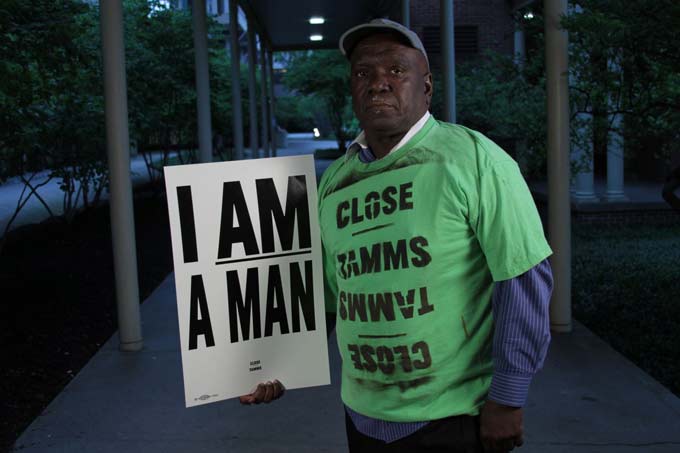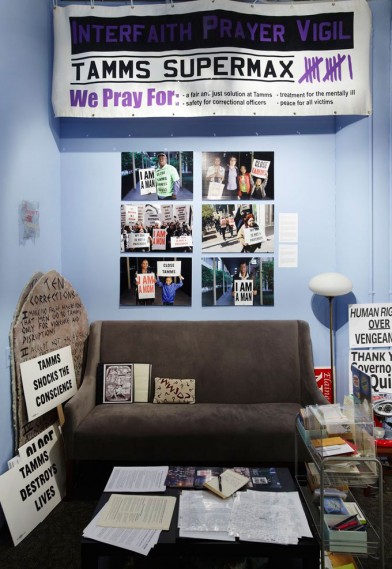Tamms Is Torture: Artists & Activists Campaign to Close an Illinois Supermax Prison

Melvin Haywood, pictured above, spent eight years in solitary confinement at Tamms Supermax until the Prisoner Review Board granted him parole from prison.
Artist Laurie Jo Reynolds (2012 Emerging Fields) and art historian Stephen F. Eisenman co-authored an account of the five-year campaign to close the Tamms Supermax Prison in Illinois. Their story follows, and you can find the full article on Creative Time Reports.
Illinois Lost Its Head
In 1998, Illinois opened a prison without a yard, cafeteria, classrooms or chapel. Tamms Supermax was designed for just one purpose: sensory deprivation. No phone calls, communal activities or contact visits were allowed. Men could only leave their cells to shower or exercise alone in a concrete pen. Food was pushed through a slot in the door. The consequences of isolation were predictable: many men fell into severe depression, experienced hallucinations, compulsively cut their bodies or attempted suicide.
The first men at Tamms were transferred there from other prisons around the state for a one-year shock treatment intended to break down disruptive prisoners and make them more compliant. But the Illinois Department of Corrections (IDOC) left them there indefinitely. A decade later, more than a third of the men at Tamms had been there since it opened, and for no apparent reason.
Research has shown that supermax prisons don’t reduce prison violence or rehabilitate prisoners. On the contrary, isolation induces or exacerbates mental illness, creates stress and tension, worsens behavior and undermines the ability of people to function once they get out.
Despite its uselessness as a form of correction, Tamms had many strong supporters: the powerful union to which the prison guards belonged, the nearby towns that welcomed the well-paid jobs, and state officials who thrived on tough-on-crime politics. They all deployed a single phrase meant to paralyze any possible dissenters: the worst of the worst. This slogan was applied to the men at Tamms to suggest they deserved the worst possible treatment—long-term solitary confinement that human rights monitors uniformly describe as cruel, inhuman and degrading, if not outright torture. Challenging this label and this punishment became the project of Tamms Year Ten, a campaign launched in 2008, a decade after the supermax opened.
Punching Above Our Weight
Two years earlier, a group of Chicago artists, poets and musicians formed the Tamms Poetry Committee. Two of them, Laurie Jo Reynolds included, had been members of a group that had protested plans to construct the supermax. Following the practice of two women who sent holiday cards to the prison, we sent letters and poems to every man at Tamms to provide them with some social contact. Their replies demonstrated the necessity of this project: “Hi Committee, is this for real? I can’t believe someone cares enough to send a pick-me-up to the worst-of-the-worst. Well, if nobody else has said it, I will: THANK YOU.” But we quickly found ourselves deluged with pleas for help: “Hey, this poetry is great, but could you please tell the governor what they’re doing to us down here?”
By 2008, we had connected with men on the outside who had spent years in Tamms and family members of current prisoners. Together, we launched the Tamms Year Ten campaign. Our goal was to educate the public about Tamms and hold the IDOC, legislators and then-Governor Blagojevich accountable for the use of long-term isolation. Prison reform is hard enough, but getting people to stand up for “the worst of the worst” was considered hopeless. Attorneys and veteran prisoner advocates warned that this campaign could endanger the men and increase support for the prison. But we believed that recent controversy over solitary confinement and torture at Guantanamo Bay and Abu Ghraib opened a new space for debate. And in any case, after a decade of isolation with no end in sight, the men in Tamms didn’t have much to lose.
Outrage Properly Directed
It was hard to know where to begin. Not many people had even heard of Tamms, located at the southern tip of Illinois, 360 miles from Chicago. Our members consulted with legislators from all over the state and sought advice from every quarter. A turning point was meeting Julie Hamos, an Evanston legislator known as a problem-solver. Her moral outrage was gratifying: “Ten years? This is unacceptable.” She felt that the best strategy was to force the IDOC to publicly justify itself. But that meant we had to have enough information to stand up to intransigent prison officials and law-and-order politicians. So we read, researched, filed Freedom of Information Act requests, extracted data from the public record and gathered statements from prisoners and their family members.
On April 28, 2008, our friend, the late Representative Eddie Washington from Waukegan, chaired public hearings on Tamms to focus legislators’ attention on the issue. We were supported by attorneys who had litigated on behalf of men at Tamms with mental illness. The testimony was often wrenching, but the IDOC was unmoved. Nevertheless, the sheer size of the audience—more than a hundred people came out—catapulted our legislative campaign. Through forums, lobby days, press conferences, rallies, prayer vigils and parsley-eating contests, we gained the support of 70 organizations and 27 legislators for a reform bill sponsored by Hamos. She also initiated roundtable discussions between Tamms Year Ten, the IDOC and legislators. The highlight of these meetings was seeing the real experts—the men recently released from Tamms—confront their former captors.
When Opportunities Are Seized, They Multiply
In 2009, the stars began to align. Amnesty International issued a statement condemning the conditions at Tamms as “harsh,” “unnecessarily punitive” and “incompatible with the USA’s obligations to provide humane treatment for all prisoners.” The organization contacted Illinois state officials, urging them to support our reform legislation. So did Human Rights Watch. Then Representative Luis Arroyo encouraged us to present our case to the House Appropriations Committee during its annual review of the IDOC budget. He opened the session with remarks about how international human rights monitors—and his own constituents—wanted the torture at Tamms to end. The hearing became a referendum on the supermax.
A month later, and just a year after the campaign went public, our new governor, Pat Quinn, announced he was replacing the IDOC chief with a reform-minded director whose first task was to review the supermax. This was followed by a Belleville News Democrat exposé that described men at Tamms with untreated schizophrenia and knots of scar tissue from self-mutilation. It also documented cases in which men entered Tamms with short sentences but wound up with life terms because of their mental illnesses. Their investigation revealed that more than half the men at Tamms had never even committed an offense in another prison. Amnesty released another, more strongly worded statement asserting that “the conditions at the supermax flout international standards for humane treatment.” In September 2009, the IDOC director announced a 10-point plan for reform that included an improvement in conditions, meaningful due process hearings and an administrative review of each man in Tamms. We had cracked the nut.
Torture Is a Crime, Not a Career
By 2011, the promised reforms were stalled, in spite of a new federal court ruling that men at Tamms had been deprived of their due process rights. But at just this point, Representative Arroyo became Chair of the House Appropriations Committee, and pushed not for the reform, but for the closure of Tamms. And in February 2012, Governor Quinn followed suit due to the state’s budget crisis and human rights concerns. In response, downstate legislators and the guards’ union (AFSCME) orchestrated a scare campaign, falsely asserting that closing Tamms would make the prison system more dangerous. Family members, outraged by the union’s shamelessness, responded: “Torture is a crime, it shouldn’t be a career.” The battle played out in the media, the courtroom and especially the budgeting process. Last year was considered “one of the most contentious episodes in the history of Illinois penitentiaries” and the mothers, sisters, nieces, children and spouses of Tamms prisoners were at the forefront of the struggle to shut the supermax down. They lobbied legislators weekly in Springfield and led marches and rallies in Chicago.
Illinois has no private prisons and a Democratic supermajority in both chambers, yet it is notoriously difficult to close any state facility. We don’t have 50,000 people in prison because of an amorphous “prison industrial complex” hell-bent on selling uniforms, steel doors and honey buns. This state’s mass incarceration can be explained by a powerful guards union, Democratic legislators beholden to it, downstate legislators zealous to protect jobs in their districts, and mass media that promote fear-based policies. It takes guts to close a prison anywhere, but it is especially hard in Illinois. Yet Governor Quinn exemplified true leadership and closed Tamms on January 4, 2013. He chose fiscal prudence over pork-barrel spending; evidence-based policies over myth and fear; and human rights over vengeance.
Why Artists?
Artists were fundamental to the campaign to close Tamms. Accustomed to attempting the impossible, artists are well qualified to affect law and policy. And compared to the regular political players, they have the freedom of the outsider: they are in the world, but not of it.
For much of the last year, the Tamms Year Ten office and its documents were showcased as an exhibition in the Sullivan Galleries at the School of the Art Institute of Chicago. But our campaign didn’t just use art forms like poetry, photography, graphic design and songs for the purposes of politics; it was itself what we call Legislative Art.

In 2012, the School of the Art Institute of Chicago exhibition Tamms Year Ten Campaign Office, in the Sullivan Galleries, served as the hub for the campaign to close the supermax. The office contained all the files and ephemera from the then five-year-long political battle and was the site of an active campaign. Volunteers met and worked around the clock while gallery visitors stopped by to observe, ask questions and even sit down and help. Photo by Tony Favarula, 2012.
For centuries, artists have been concerned with systems of ratio, perspective, symmetry, geometry, anatomy, tactility and optics. For the last 50 years, they have taken on ecology, real estate, advertising, media, cybernetic, genetic, language, gender, racial and class systems. As political artists with real-world political goals, we needed to engage with government systems. Prison policies are made by governments and that is where you go to change them.
This campaign required the endurance, commitment and even obsession that serious art always does, as well as the unity associated with a religious or political movement. People who had stumbled alone forged a collective path. Tamms prisoners sent critical information, galvanizing testimony and prayers. Men once active in enemy gangs publicly spoke side by side about the damage of isolation. Even families of men no longer in the supermax lobbied for sons left behind. Artists lent their skills, advocates issued statements, attorneys battled in court—and principled public officials stood their ground. Out of isolation came solidarity.
We are enthusiastic about Legislative Art because it is stimulating, unpredictable and rewarding. But mainly because it is necessary. Real-world politics is new terrain for most artists, but it’s too important to leave to the politicians.
You can read letters from men formerly held at Tamms on Creative Time Reports and view the related series “Photo Requests from Solitary” on The Daily Beast.
